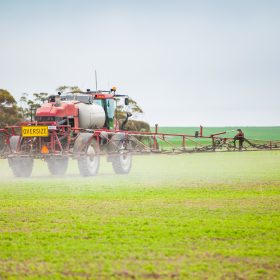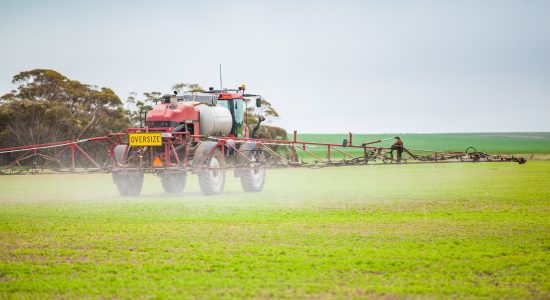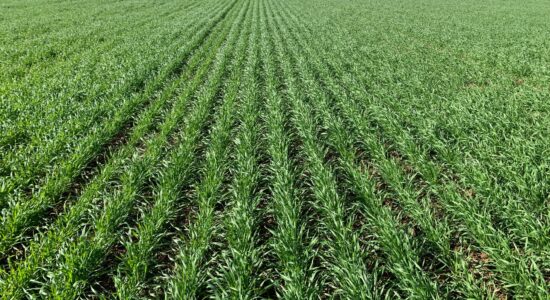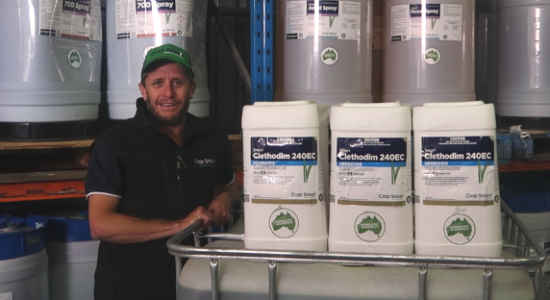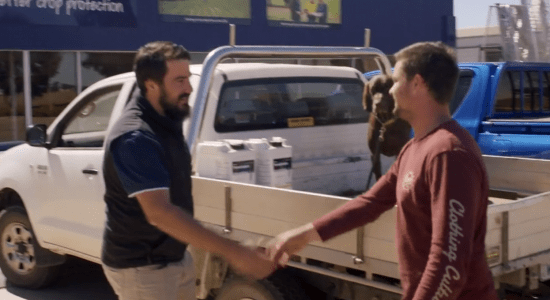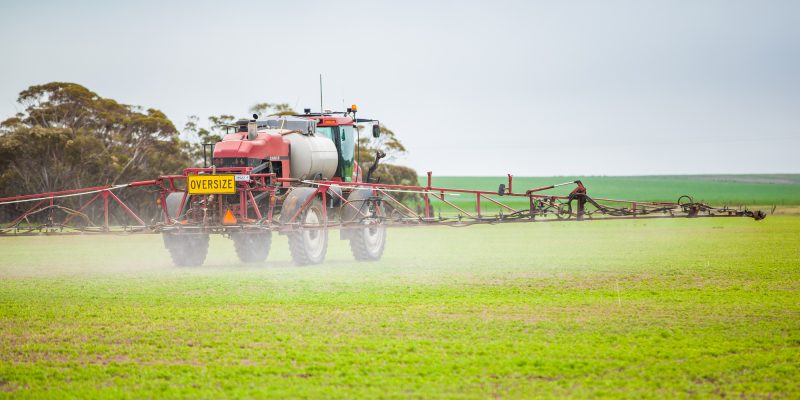
Spray drift instructions for Smart Pass 450
Spray drift instructions for Smart Pass 450
THIS IS A PHENOXY HERBICIDE THAT CAN CAUSE SEVERE DAMAGE TO NATIVE VEGETATION AND SUSCEPTIBLE CROPS SUCH AS COTTON, GRAPES, TOMATOES, OILSEED CROPS AND ORNAMENTALS.
RESTRAINTS
DO NOT apply in a manner that may cause an unacceptable impact to native vegetation, agricultural crops, landscaped gardens and aquaculture production, or cause contamination of plant or livestock commodities, outside the application site from spray drift. The buffer zones in the relevant buffer zone tables below provide guidance but may not be sufficient in all situations. Wherever possible, correctly use application equipment designed to reduce spray drift and apply when the wind direction is away from these sensitive areas.
DO NOT allow bystanders to come into contact with the spray cloud.
DO NOT apply unless the wind speed is between 3 and 15 kilometres per hour at the application site during the time of application.
DO NOT apply if there are surface temperature inversion conditions present at the application site during the time of application. These conditions exist most evenings one to two hours before sunset and persist until one to two hours after sunrise.
Recognising a surface temperature inversion
A surface temperature inversion is likely to be present if:
- mist, fog, dew or a frost have occurred
- smoke or dust hangs in the air and moves sideways, just above the ground surface
- cumulus clouds that have built up during the day collapse towards evening
- wind speed is constantly less than 11 km/hr in the evening and overnight
- cool off-slope breezes develop during the evening and overnight
- distant sounds become clearer and easier to hear
- aromas become more distinct during the evening than during the day.
Information from GRDC Fact Sheet: ‘Surface Temperature Inversions and Spraying’, Jul 2014.
Spray timing
- Spray during the day wherever possible. Vertical mixing of the air makes surface temperature inversions unlikely and will reduce the risk of drift caused by surface temperature inversions.
- There is a very low risk of surface temperature inversion when there is continuous overcast weather, with low and heavy cloud and/or wind speed remains above 11km/h for the whole period between sunset and sunrise.
- A lack of suitable weather conditions for spraying over extended periods is not an excuse for spraying in unsuitable conditions.
DO NOT apply if crop or weeds are stressed due to dry or excessively moist conditions.
DO NOT apply with spray droplets smaller than VERY COARSE spray droplets according to the ASAE S572.1 definition for standard nozzles.
DO NOT use if rain is likely within 6 hours.
Monitoring and record keeping
Users of this product MUST make an accurate written record of the details of each spray application within 24 hours following application and KEEP this record for a minimum of 2 years. The spray application details that must be recorded are: 1- date of use with start and finish times of application; 2- the specific location which must include address and paddock/s sprayed; 3- Product trade name (full name) of the product being used; 4- rate of application which must include the amount of product used per hectare and number of hectares applied to; 5- situation, crop or commodity to which the chemical was applied; 6- wind speed and direction during application; 7- air temperature and relative humidity during application; 8- nozzle brand, model, size, type, and spray system pressure measured during application; 9- height of spray boom from ground ; 10- name and contact details of person applying this product (Additional record keeping and/or details may be required by the state or territory where this product is used).
Watch for changes in weather conditions. Stop spraying immediately if a surface temperature inversion occurs or if spraying conditions become unsuitable for any other reason.
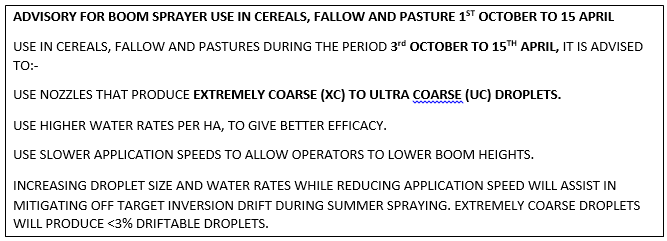
BOOM SPRAYERS (ground application)
DO NOT apply by a boom sprayer unless the following requirements are met:
- spray droplets not smaller than a VERY COARSE (VC) spray droplet size category (minimum XC between 3 October and 15 April – advisory)
- boom heights 0.5 metres or lower above the target canopy (The higher of either the crop canopy or the targeted weeds)
- minimum distances between the application site and downwind sensitive aquatic and wetland areas including aquacultural ponds, surface streams and rivers (see Aquatic ‘Downwind mandatory no-spray zone’ section of the following table titled ‘Buffer zones for boom sprayers’) are observed.
- minimum distances between the application site and downwind sensitive crops, gardens, landscaping vegetation, protected native vegetation or protected animal habitat (see Terrestrial ‘Downwind mandatory no-spray zone’ section of the following table titled ‘Buffer zones for boom sprayers’) are observed. The buffer zones provide guidance but may not always be completely protective of all agricultural crops.
BUFFER ZONES FOR BOOM SPRAYERS:

AERIAL APPLICATION
DO NOT apply by aerial application unless the following requirements are met:
- spray droplets not smaller than a VERY COARSE (VC) spray droplet size category.
- release heights 5 metres or lower above the target canopy
- minimum distances between the application site and downwind sensitive aquatic and wetland areas including aquacultural ponds, surface streams and rivers (see Aquatic ‘Downwind mandatory no-spray zone’ section of the following table titled ‘Buffer zones for aircraft) are observed.
- minimum distances between the application site and downwind sensitive crops, gardens, landscaping vegetation, protected native vegetation or protected animal habitat (see Terrestrial ‘Downwind mandatory no-spray zone’ section of the following table titled ‘Buffer zones for aircraft) are observed. The buffer zones provide guidance but may not always be completely protective of all agricultural crops.
BUFFER ZONES FOR AIRCRAFT: 3 metre release height or lower above the target canopy
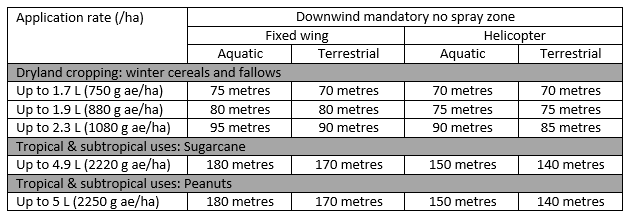
BUFFER ZONES FOR AIRCRAFT: 5 metre release height or lower above the target canopy
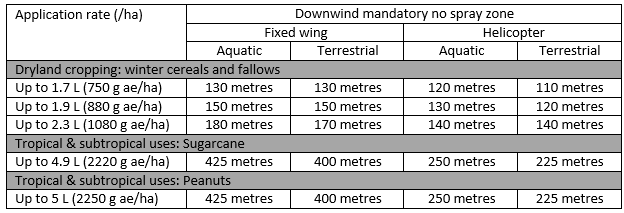
Pasture application by air – 5.0 m release height
Product Groups 1, 12, 15 (orchards), 16 (turf), 17, 20 and 21 do not contain separate pasture uses. For all other groups, rates range from 90 – 9000 g ae/ha. These pasture uses and application rates are highly variable between different product groups. The highest rates for individual product groups that are supported are modelled below and the corresponding buffer zones are provided for two wind speed ranges.
NOTE: some rates ARE NOT SUPPORTED for Fixed Wing aircraft and MUST NOT be applied by fixed wing aircraft
Application rate 2750 g ae/ha, VERY COARSE droplet size, Aerial application
Aquatic protection

Terrestrial protection (2,4-D salt formulations)

Application rate 2000 g ae/ha, VERY COARSE droplet size, Aerial application

Terrestrial protection (2,4-D salt formulations)

Pasture application – 3.0 m release height
Product Groups 1, 12, 15 (orchards), 16 (turf), 17, 20 and 21 do not contain separate pasture uses. For all other groups, rates range from 90 – 9000 g ae/ha. These pasture uses and application rates are highly variable between different product groups. The highest rates for individual product groups that are supported are modelled below and the corresponding buffer zones are provided for two wind speed ranges.
NOTE: some rates ARE NOT SUPPORTED for Fixed Wing aircraft and MUST NOT be applied by fixed wing aircraft
Application rate 2750 g ae/ha, VERY COARSE droplet size, Aerial application
Aquatic protection

Terrestrial protection (2,4-D salt formulations)

Application rate 2000 g ae/ha, VERY COARSE droplet size, Aerial application
Aquatic protection

Terrestrial protection (2,4-D salt formulations)


